Paris for First-Time Visitors: Tips, Must-Sees & What I Wish I Knew
Welcome to the enchanting world of Paris—a city that truly needs no introduction, yet never fails to steal the hearts of travelers, especially those experiencing it for the very first time. If you’re planning your first trip to Paris, this guide is your go-to resource for everything you need to know before you go.
Paris for first-time visitors can feel like a whirlwind of romantic cobblestone streets, iconic landmarks, dreamy cafés, and cultural delights. But with so much to see and do, it’s easy to feel a little overwhelmed. Don’t worry—I’ve got you covered!
From choosing the perfect arrondissement to call home, mastering the Metro like a local, and uncovering the must-see sights that make Paris magical, this guide is packed with practical Paris travel tips and insider advice. I’ll also share what to wear, how to tip, and where to dine, so you can feel confident and stylish every step of the way.
So slip on your comfiest walking shoes, embrace the art of flânerie, and let the City of Light work its irresistible charm. Your first time in Paris starts right here.
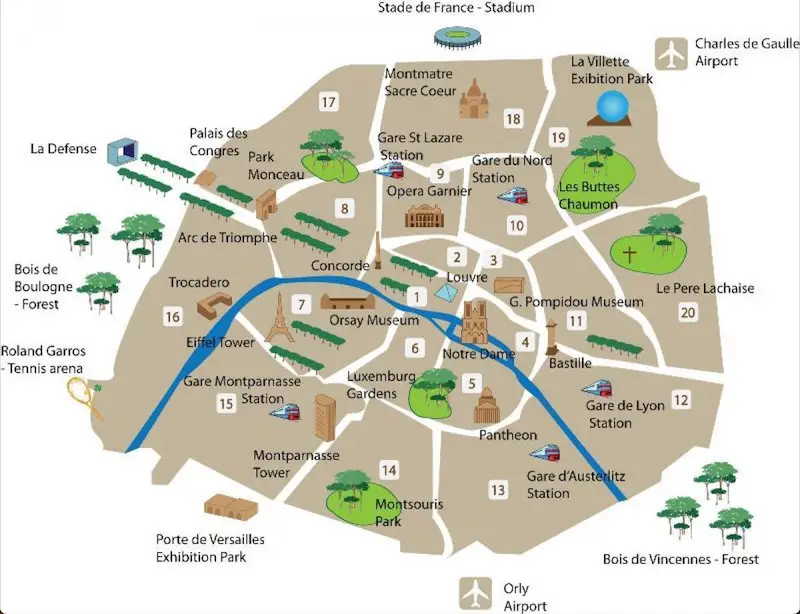
How to Choose the Best Arrondissement to Stay in Paris
Location, location, location! When it comes to planning your first time in Paris, where you stay can make or break your trip. Enter: the arrondissements—Paris’s 20 numbered districts that spiral out like a snail from the city center.
Think of arrondissements like boroughs or neighborhoods, each with its own personality, vibe, and charm. Whether you want postcard-perfect views of the Eiffel Tower, cute cobblestone streets, or buzzing nightlife, there’s a district for every type of traveler.
To help you choose the best area for your adventure, I’m breaking down the most popular arrondissements for first-time visitors to Paris—from charming Montmartre to elegant Saint-Germain-des-Prés. (We’re skipping the 2nd arrondissement, since it’s mostly business-y.)
Arr. 1 is the city center and the numbers spiral out from there in a circle (view the map in the photos below). Typically, the closer to the city center, the better, often more costly but near to key landmarks, though each has its own charm. This district is home to some of the most famous buildings and landmarks in the French capital. A must-visit includes Ile de la Cité, Place Vendôme, Pont Neuf, the Tuileries Gardens, the Louvre, and the Seine River. Learn more about arrondissements here.
- Arr. 3 is home to Le Marias, a trendy, charming shopping area with galleries, boutiques, and cafés.
- Arr. 4 includes the other half of Le Marais, the other half of Isle de la Cité, the Pompidou Center (with George’s restaurant on top – highly recommend), and Notre Dame. It’s also a great place to stay, and the gay district of Paris.
- Arr. 5, or Latin Quarter is notable for its ancient streets and the Sorbonne University.
- Arr. 6, Saint-Germain-des-Près is great for foodies with many gourmets, chocolate, and pastry shops.
- Arr. 7 is home to the Eiffel Tower, big avenues, and private luxe mansions, and is known as the bourgeois district. You’ll also find the Tomb of Napoleon here and the Orsay Museum. For an unusual tour, check out the Paris Sewer Museum.
- And the 8th, my personal favorite and most romantic is where you’ll find the famous “Golden Triangle”, the best cabarets, luxury shopping, and beautiful views from the top of the Arc de Triomphe.
Best Areas to Stay When Visiting Paris For First-Time Visitors

The Top 5 Places to Stay in Paris for First-Time Visitors
If you’re visiting Paris for the first time and wondering where to base yourself—don’t stress, I’ve got you covered. With 20 arrondissements (aka districts) that each have their own charm, picking the right one can feel overwhelming.
So to help you narrow it down, I’ve rounded up my top 5 favorite places to stay in Paris for first-time visitors. These neighborhoods offer the perfect mix of iconic sights, walkable streets, chic cafés, and that je ne sais quoi Paris is known for.
Whether you’re dreaming of Eiffel Tower views, shopping on the Champs-Elysées, or wandering historic lanes in the Marais, there’s a perfect corner of Paris waiting for you. I’ve also added hotel recs for every budget—from luxe to low-key.
🥐 Where to Stay in Paris for First-Time Visitors
1. 8th Arrondissement – Elegant & Central
The 8th is all about Parisian glamour. Home to the Champs-Elysées, the Arc de Triomphe, and high-end shopping, it’s ideal if you want to be in the heart of it all. It’s upscale, polished, and super walkable.
➡️ Luxury: Four Seasons Hotel George V Paris – Iconic Parisian elegance steps from the Champs-Elysées.
➡️ Mid-Range: Hôtel Le 123 Elysées – Astotel – Stylish boutique stay with free snacks and a central location.
➡️ Budget: Hôtel Elysée Etoile – Affordable, cozy, and just a stroll from the Arc de Triomphe.
2. Saint-Germain-des-Prés – Artsy & Sophisticated (6th)
This Left Bank gem is known for its literary cafés, chic boutiques, and art galleries. Staying here puts you close to the Louvre, Musée d’Orsay, and the Seine. It’s stylish, central, and oh-so Parisian.
➡️ Luxury: Hôtel d’Aubusson – A 5-star boutique hotel exuding Parisian charm, featuring elegant rooms and a renowned jazz bar.
➡️ Mid-Range: Hôtel Artus – Chic and contemporary, this 4-star hotel offers a sauna and is steps away from Mabillon Metro Station.
➡️ My Boutique Budget: Hôtel De Seine – A charming hotel offering classic Parisian ambiance in the heart of Saint-Germain.
3. Le Marais – Trendy & Historic (4th)
Buzzing with energy and charm, the Marais is one of Paris’s coolest neighborhoods. Think cobblestone streets, indie shops, vintage finds, and falafel stands.
Bonus: it’s walkable to Notre-Dame, Place des Vosges, and the Seine.
➡️ Luxury: Le Grand Mazarin – A newly opened 5-star hotel blending French elegance with modern luxury, located near iconic attractions.
➡️ Mid-Range: Hotel L de Lutece – Historic charm meets cozy elegance on the quiet Île Saint-Louis.
➡️ Budget: MIJE Marais – A popular choice for budget travelers, offering affordable dormitory-style rooms in a central location.
4. 7th Arrondissement – Iconic Views
If seeing the Eiffel Tower sparkle at night is at the top of your list, the 7th is your spot. It’s home to several must-see sights like the Eiffel Tower, Musée Rodin, and the Musée d’Orsay, plus it has a relaxed residential vibe.
➡️ Luxury: Pavillon Faubourg Saint-Germain & Spa – Chic Left Bank stay with refined rooms and a luxe on-site spa.
➡️ Mid-Range: Hôtel Le Cercle Tour Eiffel – A stylish hotel located just a short walk from the Eiffel Tower.
➡️ Budget: Hôtel de la Tour Eiffel – An affordable option offering basic amenities and close proximity to major attractions.
5. 16th Arrondissement – Quiet & Classy
Want to feel like you’re living in Paris instead of just visiting? The 16th is elegant and residential with tree-lined streets, gorgeous architecture, and easy access to parks and museums. It’s great for a more local experience while still being well-connected.
➡️ Luxury: The Peninsula Paris – A 5-star hotel offering opulent rooms, a rooftop restaurant with stunning views, and a luxurious spa.
➡️ Mid-Range: Hôtel Passy Eiffel – A charming hotel located near the Eiffel Tower, offering comfortable rooms and a cozy atmosphere.
➡️ Budget Options – Visit the list of hotels and apartments.
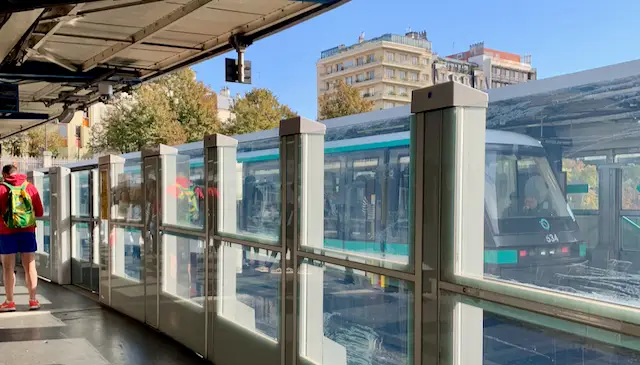
🚇 Transportation in Paris for First-Time Visitors: How to Get Around Like a Local
There’s nothing quite like strolling the charming streets of Paris, latte in hand, soaking in the architecture and atmosphere. But let’s be real—sometimes you’ve got places to be (bonjour, Eiffel Tower!), and that’s where Paris’s transportation system shines.
Getting around Paris is surprisingly easy, even if it’s your first time. Whether you’re hopping on the Metro, catching a bus, or biking through the boulevards, here’s what you need to know to navigate the City of Light like a pro.
🚇 Metro
The Paris Metro is fast, affordable, and super efficient. With 14 lines and over 300 stations, it’ll get you just about anywhere in the city. Trains run from around 5:30 AM to 1:00 AM (later on weekends), and a single ride costs about €2.15. Download the RATP app or use Citymapper to plan your route easily.
Tip: Buy a carnet (pack of 10 tickets) or a Navigo Easy pass to save money if you’ll be riding a lot.
🚌 Bus
Buses are a scenic and relaxed way to get around Paris, and they cover some areas the Metro doesn’t. They run from about 6:00 AM to 8:30 PM, with some night buses available. You can use the same Metro tickets (or your Navigo pass) on buses.
Tip: Sit by the window and enjoy the ride—it’s like a mini city tour!
🚲 Biking
Paris is super bike-friendly, thanks to tons of dedicated bike lanes and the city’s Vélib’ bike-sharing program. You can rent a regular or electric bike at one of hundreds of docking stations. It’s perfect for short rides, and there’s nothing more Parisian than cruising along the Seine on two wheels.
👟 Walking
Truly, the best way to discover Paris is on foot. Most iconic sights are within walking distance, and you’ll stumble on adorable cafés, hidden courtyards, and Insta-worthy corners that aren’t on any map. Wear comfy shoes—you’ll thank me later!
🚕 Taxis & Ubers
Both are widely available, though Ubers tend to be cheaper and easier to use with the app. Taxis have a base fare of around €2, with minimum charges usually around €6. Not all taxis accept cards, so it’s smart to carry some cash.
Pro tip: Use Taxi G7, Paris’s largest and most reliable taxi service—they accept credit cards and you can book through their app.
First-Timer Travel Tip: Always keep your destination address written down (or saved in your phone). Not all drivers speak English, and a hotel card or screenshot of your Airbnb address goes a long way.
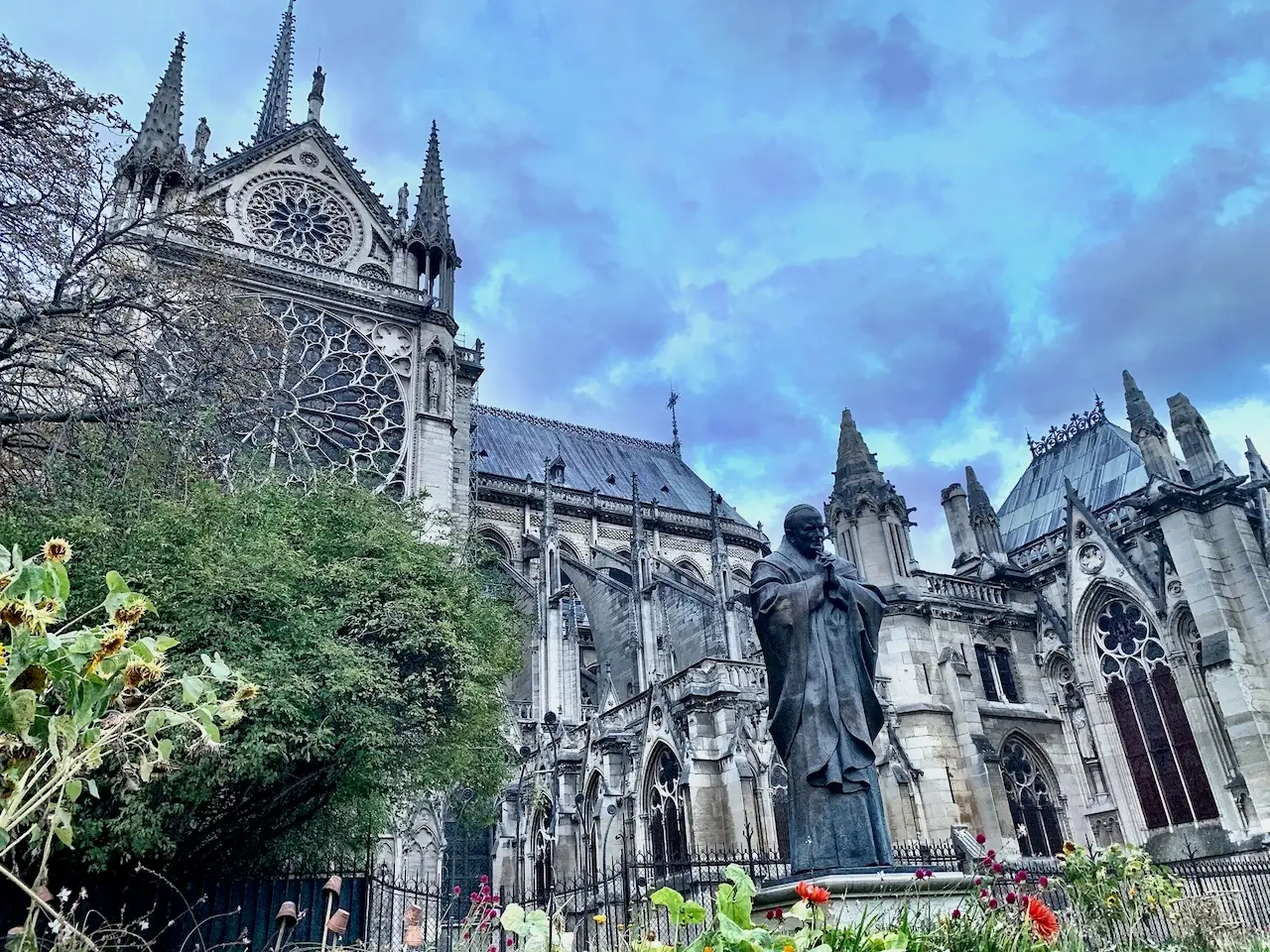 Tours and Sightseeing in Paris for First-Time Visitors
Tours and Sightseeing in Paris for First-Time Visitors
When you’re visiting Paris for the first time, it can be a bit overwhelming knowing where to start. My favorite travel hack? Spend your first day on a Hop-On Hop-Off bus tour—but don’t get off! Cruising through the city gives you a feel for the layout, a glimpse of all the major sights, and helps you get your bearings before diving into the details.
If you’re planning to visit iconic landmarks like the Eiffel Tower (which sees nearly 9 million visitors a year!), book your guided tours early—especially if you want skip-the-line access. A priority-access Eiffel Tower tour can save you hours of waiting, letting you soak in the views instead of the crowds.
Pro tip: The Eiffel Tower has not one, but two Michelin-starred restaurants. Book these well in advance—they’re an unforgettable splurge.
Ten essential must-see sites when visiting Paris for first-time visitors
-
The Eiffel Tower (Arr. 8) symbolizes Paris. Nothing like doing this in person, though it’s a highly visible landmark that can be seen from many points in the city, and Seine River Tours.
-
Louvre Museum – (Arr. 1) On our first visit, we attempted to see everything. Don’t. You just can’t. It’s too big. View what inspires you and of course, see Leonardo di Vinci’s Mona Lisa and two famous Greek statues, Venus de Milo and the Winged Victory of Samothrace. Figure out your strategy before you enter.
-
Musée d’Orsay – Possibly my favorite Museum. Also recently learned during our visit to Philly’s Barnes’ Foundation, that they have reciprocal entry. Enjoy their magnificent collection of world-famous Impressionist and Post-Impressionist art including Van Gogh’s Starry Night. The skip-the-line ticket is well worth it during busy seasons.
-
Versailles Palace – one of largest palaces in the world, it’s most famous for its occupants, the Hall of Mirrors and the magnificent gardens. A guided tour here is well worth it as the security line will go faster, plus they’ll typically take care of transportation since Versaille is about 12 miles from the city.
-
The Marais – (Arr. 3 & 4) – Very hip, trendy with cobblestone streets, boutiques, museums, and gardens. It’s the perfect neighborhood in Paris for flâner, wandering aimlessly around the city to experience it. There are walking tours but we’ve always enjoyed meandering in and out of the streets.
-
Latin Quarter (Arr. 5) in the Left Bank – explore the narrow, winding, cobblestone streets that remind us of what the medieval city of Paris looked like. Also home to the Sorbonne and the Pantheon.
-
Seine River – It defines the Left Bank from the Right Bank, cutting through the city. I think the nicest way to see is to walk its banks, but river tours are also a relaxing way to take in the river and the city. Île de la Cité, is one of two islands with medieval masterpieces, parks, and Notre Dame Cathedral. Due to the 2019 fire, this cathedral was closed for renovation, and has since reopened.
-
Montmartre and Sacré Coeur – (Arr. 18) The entrance is free, with no guided visits. It’s atop a hill and visible from almost everywhere. There are no elevators either. Word of caution, we have seen more than one pick-pocket incident here, so keep your belongings close and don’t put them down to get that selfie.
-
Arc de Triomphe – This iconic landmark was commissioned in 1806 by Napoleon. Definitely do the observation deck at the top for 360 degree views.
-
The Paris Passages – They’re the city’s original shopping malls and full of tiny boutiques, bookstores, antique shops, cafés, and more uniquely Parisian spots. Explore Galerie Vivienne, Passage des Panoramas, Galerie Véro-Dodat, and Passage Colbert.
What Should You Wear in Paris? Fashion Tips for First-Time Visitors
One of the most common questions travelers ask is: What should you wear in Paris? The good news is that there’s no strict dress code. Paris is stylish, yes—but it’s also a diverse, cosmopolitan city where people dress in a wide range of styles. That said, there are a few tried-and-true tips that will help you feel comfortable, confident, and just a little more Parisian.
- Start with layers. The weather in Paris can change quickly, even in the same day, so packing light layers is a smart move. A trench coat, cardigan, or lightweight jacket will keep you prepared for anything, and a scarf is always a good idea—practical, and very on-brand in Paris.
- Skip the shorts, especially if you want to blend in with locals. While you’ll see tourists in shorts, most Parisians opt for dresses, skirts, or relaxed trousers in warmer weather. It’s not a rule, just a way to feel less like a tourist and more like you belong.
- Wear comfortable shoes. Paris is a walking city, and the charming cobblestone streets can be unforgiving in heels. Think sneakers, loafers, or cute flats. If you’re set on wearing heels for a dinner out, pack them in your bag and change once you arrive.
- Leave space in your suitcase for shopping. Even if you didn’t plan to buy anything, Paris might surprise you. Between department stores, boutiques, and flea markets, there’s fashion at every level. I once found a vintage couture Dior blazer at a flea market—and I still wear it 20 years later.
- Finally, be respectful of local customs. While Paris is a liberal city, it’s still polite to avoid revealing clothing or anything with offensive graphics. Dress in a way that feels like you, just with a little extra thoughtfulness and style.
Dining in Paris: What First-Time Visitors Should Know
When it comes to dining in Paris, where do you even begin? I originally planned to write a full guide on where to eat—but quickly realized I’d be typing for days. There are just that many amazing places to try, from classic bistros and wine bars to neighborhood bakeries and Michelin-starred spots.
Some of my favorite meals in Paris weren’t even from a must-try list—they were spontaneous finds while wandering around a new arrondissement. So my best advice? Stay curious, keep your eyes open, and follow your nose.
For planning ahead, apps like The Fork, OpenTable, and good old Google Maps are super helpful when you’re on the ground. You can filter by price, cuisine, and neighborhood, and even check photos and reviews. Reservations are recommended, especially for dinner and weekends.
Paris caters to every taste and budget. Whether you’re into multi-course fine dining or a €5 jambon-beurre eaten on a park bench, you’ll be in absolute foodie heaven. Don’t be afraid to try something new—yes, even foie gras or escargot! The French really are masters of flavor and technique.
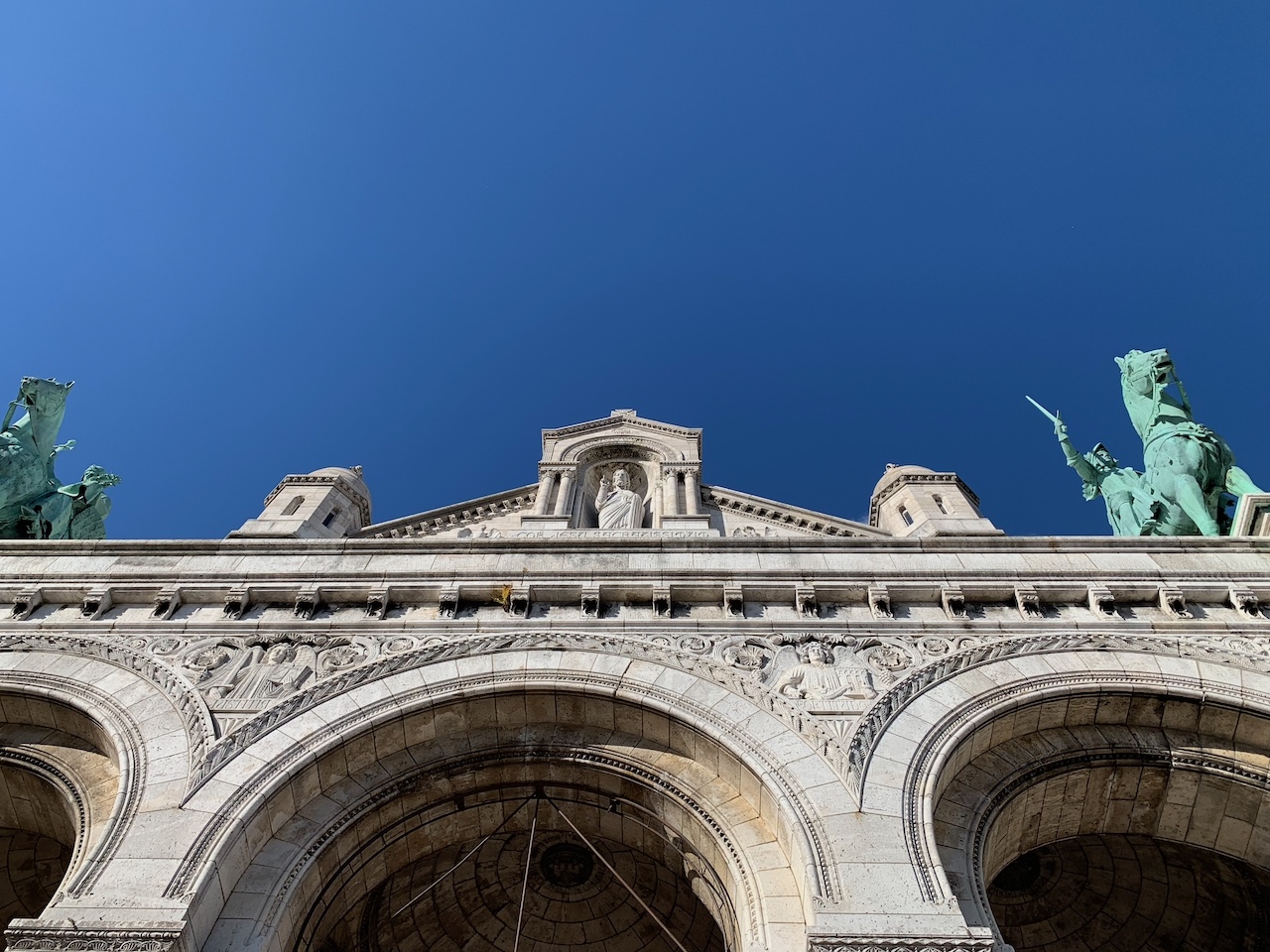 Frequently Asked Questions for First-Time Visitors to Paris
Frequently Asked Questions for First-Time Visitors to Paris
What’s the best time to visit Paris?
Paris is stunning year-round, but spring (April–June) and fall (September–October) are ideal for mild weather, blooming gardens, and fewer crowds. Summer is lively but touristy, and winter brings cozy charm, especially around the holidays.
What are some essential Paris travel tips for first-timers?
Carry a reusable water bottle, learn a few key French phrases, and keep your belongings secure—especially on public transport. Public restrooms often require coins, so keep some change handy. Always greet people with a polite Bonjour.
How do I handle money in Paris?
Credit and debit cards are widely accepted, but it’s smart to carry some euros for tips, cafés, and small shops. Use ATMs (called DABs) for fair exchange rates, and skip airport currency booths, which charge higher fees.
Is it Safe to Travel to Paris?
Traveling to Paris is generally considered safe for tourists. Like any major city, it’s essential to exercise typical precautions, such as staying aware of your surroundings, safeguarding your belongings, and being cautious in crowded tourist areas, but Paris remains a popular and welcoming destination for travelers from around the world.
Do I need to speak French in Paris?
Not necessarily, but learning a few simple phrases like Bonjour, Merci, and Parlez-vous anglais? goes a long way. Most people in hospitality speak some English, and showing a little effort is always appreciated.
What should I wear in Paris to blend in?
We cover this in detail above, but in short: dress in layers, wear comfortable walking shoes, and keep your style classic and polished. Avoid gym wear or super casual outfits, and be ready to shop—Paris fashion is irresistible.
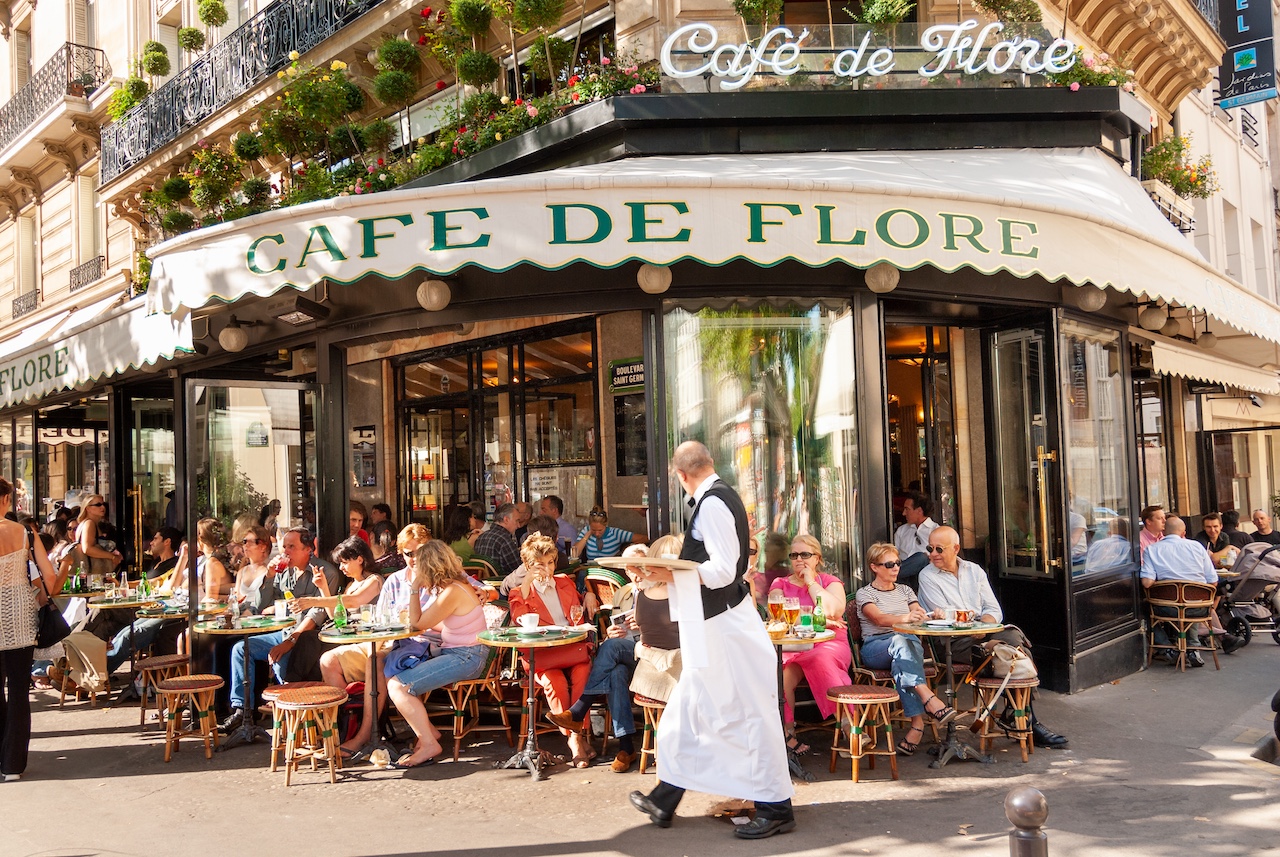
Should You Tip in Paris?
If you’re visiting Paris for the first time, you might be wondering: do you tip in Paris? The short answer is yes—but it’s a little more relaxed than in the U.S. or other countries where tipping is expected.
In restaurants, cafés, and bars, a small tip is appreciated but not required. Service is usually included in the bill (look for “service compris”), but it’s still common to leave a little extra if you had good service. Rounding up the bill or leaving about 5–10% is a nice gesture. For example, if your bill is €27.50, rounding up to €30 is perfect.
Many places prefer tips in cash, especially if you’re paying by card, as you often can’t add a tip to your receipt. When in doubt, just ask the server.
Tipping extends beyond restaurants, too. It’s customary to tip taxi drivers, hairdressers, spa staff, and even hotel porters a few euros, depending on the service. There’s no set rule—just go with what feels appropriate. A couple of euros for a quick ride or haircut is fine, or round up for convenience.
Tipping in Paris is ultimately up to you. It’s not mandatory, but it’s a kind, appreciated way to show gratitude for great service. When in doubt, a small tip and a smile go a long way.
What’s the best way to get around Paris?
Walking is the best way to explore, but the Metro is fast and affordable. Buses are great for sightseeing, and Vélib’ bikes are fun for short rides. Download the RATP or Citymapper app to navigate easily. We cover the full breakdown above.
Are there cultural etiquette rules I should know?
Yes—always say Bonjour when entering a shop, be polite and speak softly in public spaces, and dress modestly in religious sites. Don’t touch produce at markets, and avoid loud or disruptive behavior. Respect is key in Parisian culture.
Final Thoughts: Your First Trip to Paris
Planning your first trip to Paris is equal parts exciting and overwhelming—but with the right prep (and a little inspiration), it becomes the adventure of a lifetime. From picking the right arrondissement and gliding through the city on the Metro, to dressing the part and tasting your way through charming cafés, Paris for first-time visitors is every bit as magical as you imagine.
This guide was created to give you everything I wish I knew before my first visit—from cultural etiquette and tipping, to where to stay, what to wear, and how to get around. Whether you’re marveling at the Eiffel Tower, sipping espresso in a tucked-away bistro, or discovering your new favorite street by accident, Paris has a way of leaving its mark on your heart.
Above all, don’t stress the small stuff. Get lost (on purpose), linger longer, and allow yourself to experience Paris at your own pace. The City of Light has a rhythm all its own—and now, you’re ready to dance to it.
Bon voyage, and bienvenue à Paris!
Suggested Reading:







